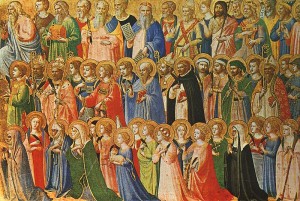 This month is a momentous one for saints in the Catholic Church. After naming two new doctors of the church this past Sunday, Pope Benedict XVI will canonize seven new saints on Oct. 21. Among them are Marianne Cope, a Franciscan sister who founded hospitals in New York before nursing lepers in Hawaii, and Kateri Tekakwitha, a New York-born contemplative who will become the church’s first Native American saint.
This month is a momentous one for saints in the Catholic Church. After naming two new doctors of the church this past Sunday, Pope Benedict XVI will canonize seven new saints on Oct. 21. Among them are Marianne Cope, a Franciscan sister who founded hospitals in New York before nursing lepers in Hawaii, and Kateri Tekakwitha, a New York-born contemplative who will become the church’s first Native American saint.
The American roots of the pope’s honorees are not the only reason his saint-making festivities matter on this side of the Atlantic. Another is the symbolic timing of his pronouncements. They coincide with the 50th anniversary of the opening of the Second Vatican Council, which advanced reforms that many American Catholics saw as discouraging devotion to the saints.
Before the council opened in October 1962, attention to the saints was a defining feature of American Catholic life. Catholics planned their social schedules around celebrations of the holy men and women whose feast days crowded the liturgical calendar. Each ethnic group had its favorites: the Irish had St. Patrick, the Germans had St. Nick, the Italians and Poles had St. Joseph. Catholic babies took their names from the canon of saints; Catholic classmates traded holy cards with the same fervor that their Protestant and Jewish counterparts swapped baseball cards; and dog-eared copies of “Butler’s Lives of the Saints” were as common as altar rails, mantillas and novenas to St. Jude.
At Vatican II, concern about saints’ feast days distracting from the central mysteries of Christ’s life led the council fathers to simplify the church’s liturgical calendar. Some saints’ days disappeared; others were moved or restricted to celebration in their local churches. The landmark council document “Lumen Gentium” reaffirmed longstanding Catholic teaching that “our companionship with the saints joins us to Christ” and Catholics should “invoke them and have recourse to their prayers, their power and help in obtaining benefits from God through His Son, Jesus Christ.” Yet the document warned against “any abuses, excesses or defects” that privilege “the multiplying of external acts” over the most authentic form of devotion to the saints: imitation of their virtues and their single-minded focus on Christ.
As with so much else that happened in the chaotic years after Vatican II concluded in 1965, the balanced tone of the council’s teaching on saints was lost amid the clamor for more radical change. Liturgists and pastors intoxicated by the “spirit of Vatican II” and the cultural upheaval of the late 1960s interpreted cautions against devotional abuses as a call to sideline the saints. The result was disorienting for many rank-and-file faithful, who walked into their parishes to find statues of their favorite patrons removed, recitation of their favorite novenas canceled, and age-old displays of reverence for their holy forebears ridiculed as relics of a retrograde, “pre-Vatican II” Catholicism.
Saints began to make a comeback with the 1978 election of Pope John Paul II. Like Benedict, John Paul was present for all four sessions of Vatican II. He saw an intrinsic link between the council’s “universal call to holiness” and devotion to the saints. If the summons to heroic virtue and eternal union with God is directed to believers in all walks of life – not just nuns, priests and popes – then today’s Catholics need more models of holiness, he reasoned, not fewer. So John Paul streamlined the church’s canonization process, beatifying 1,338 people and declaring some 482 saints – record numbers that included Catholic singles, spouses and parents, and contemporary representatives of a diverse array of professions, nationalities and spiritualities.
John Paul’s “saint factory” sparked its share of criticism, but it also ignited enthusiasm among a new generation of Catholics. Many younger Catholics who never knew the pre-Vatican II subculture that shaped their parents and grandparents have begun discovering the value of having holy companions on the spiritual journey, wise guides whose stories suggest that fleeting trials, when embraced with faith, can become the stuff of eternal glory.
Benedict has encouraged that discovery. Between 2007 and 2011, he gave more than 100 general audience addresses on the lives of the saints, and concluded by explicitly connecting their example to the lessons of Vatican II. A careful student of history with a gimlet-eyed view of the church’s position in the world today, Benedict knows that saints – and the passion for personal holiness and self-sacrifice they inspire – are keys to Church renewal in every age. As he explained to interviewer Vittorio Messori in the Ratzinger Report, “The only really effective apologia for Christianity comes down to two arguments, namely, the saints the church has produced and the art which has grown in her womb.”
As Catholics commemorate a council that opened the windows of the church to the modern world, it seems fitting that the anniversary be bracketed by ceremonies honoring the church’s best ambassadors and most beautiful works of art: its colorful, eclectic and inspiring canon of saints.
This article originally appeared in The Washington Post and is used with permission.



